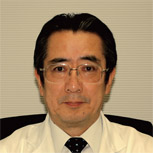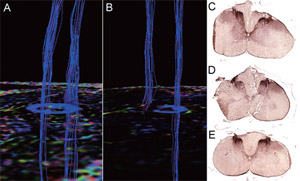HOME > Program Members > Yoshiaki Toyama

Yoshiaki Toyama

Professor, Department of Orthopaedic Surgery, Graduate School of Medicine, Keio University
Yoshiaki Toyama, MD, PhD
toyama@sc.itc.keio.ac.jp
http://www.keio-ortho.jp/noflash/index.html
Theme
Spinal cord injuries result in devastating loss of function, because spinal cord of human beings never regenerates after injury. There is an emerging hope for regeneration-based therapy of the damaged spinal cord due to the progress of neuroscience including stem cell biology. Neural stem cell transplantation is a promising regenerative medicine strategy for the treatment of spinal cord injury. We previously investigated the optimum timing of neural stem cell transplantation from the perspective of microenvironments within the injured spinal cord, and successfully transplanted rat neural stem cells into the injured spinal cord of adult rats and human neural stem cells into the injured spinal cord of common marmosets, thereby promoting functional recovery. We believe these findings represent a significant step toward the clinical application of neural stem cell transplantation. However, because of various problems, it has not yet been possible to use neural stem cells clinically. Herein, we present basic studies that have been conducted to address various barriers against the realization of regenerative medicine for SCI. These problems include: (1) ethical issues related to the use of aborted fetal tissues, (2) inhibition of the secondary injury, and (3) methods for evaluating damaged and regenerated axons within the spinal cord.
Research activities
- Characterization of neural crest stem cells as the source of transplantation for spinal cord injury
We examined the multipotency and self-renewal activity of isolated NCSCs from the bone marrow, dorsal root ganglia (DRG), and facial skin by using Protein 0 promoter-Cre/Floxed -EGFP. Since DRG-derived NCSCs showed a higher frequency of sphere formation, maintained multipotency and self-renewal ability, they are useful cellular sources for transplantation for SCI. - Intrathecal administration of recombinant human hepatocyte growth factor (HGF) promotes functional recovery after spinal cord injury in primate
We investigated therapeutic effects of HGF on SCI of nonhuman primate and showed the evidence of therapeutic effects of HGF on SCI in terms of the apoptosis inhibition and promotion of axonal regrowth and functional recovery. This study opens the possibility of clinical application of HGF for human SCI. - Diffusion tensor tractography enables in vivo tracing of neural tracts in the injured spinal cord of marmosets
We established a non-invasive method to evaluate axonal fibers in vivo using diffusion tensor tractography (DTT). DTT clearly illustrated spinal projections such as the corticospinal tract in the injured spinal cord, suggesting the feasibility of applying DTT to clinical studies of spinal cord injury.

Fig.1 In vivo corticospinal specific DTT of the spinal cords in common marmosets.
(A)DTT of the intact CST super-imposed on color-coded FA map at C5/6 level. (B) DTT of the CST in the hemisected spinal cord superimposed on color-corded FA map at C 5/6 level after injury 2 weeks. (C, D, E) CaMKII-α staining of the hemisected spinal cord at the site 8 mm cranial to thehemisectionsite(C),hemisection site (D), 8mm caudal to the hemisectionsite(E).Figureshowed no CST staining distal to the injured section at the hemisection site,suggesting CST neurotransmitter disruption.
Selected Paper
- Nagoshi N, Shibata S, Kubota Y, Nakamura M, Nagai Y, Satoh E, Morikawa S, Okada Y, Katoh H, Okada S, Fukuda K, Suda T, Matsuzaki Y, Toyama Y, Okano H. Multipotent Neural Crest-Derived Stem Cells in Bone Marrow, Dorsal Root Ganglia and Facial Skin. Cell Stem cell 2:392-403, 2008
- Fujiyoshi K, Yamada M, Nakamura M, Yamane J, Katoh H, Kitamura K, Kawai K, Okada S, Momoshima S, Toyama Y, Okano H. In vivo tracing of neural tracts in the intact and injured spinal cord of marmosets by diffusion tensor tractography. J Neurosci 27:11991-11998, 2007
- Kaneko S, Iwanami A, Nakamura M, Okano JH, Kishino A, Konishi O, Kikuchi K, Kimura T, Kumagai K, Goshima Y, Toyama Y, Okano H. Axonal Regeneration and Functional Recovery by Administration of Strong and Selective Semaphorin3A Inhibitor into the Injured Spinal Cord. Nat Med 12:1380-1389, 2006
- Iwanami A, Yamane J, Katoh H, Nakamura M, Momoshima, Ishii H, Tanioka Y, Tamaoki N, Nomura T, Toyama Y, Okano H. Establishment of graded spinal cord injury model in a non-human primate: the common marmoset. J Neurosci Res 80:172-181, 2005
- Iwanami A, Kaneko S, Nakamura M, Kanemura Y, Mori H, Kobayashi S, Yamasaki M, Momoshima S, Ishii H, Ando K, Tanioka Y, Tamaoki N, Nomura T, Toyama Y, Okano H. Transplantation of Human Neural Stem Cells for Spinal Cord Injury in Primates. J Neurosci Res 80:182-190, 2005
Copyright © Keio University. All rights reserved.
